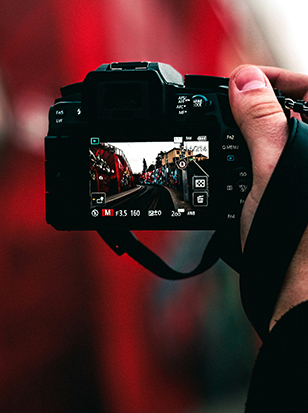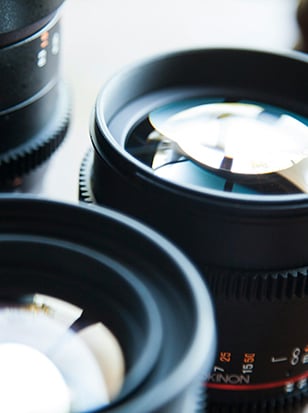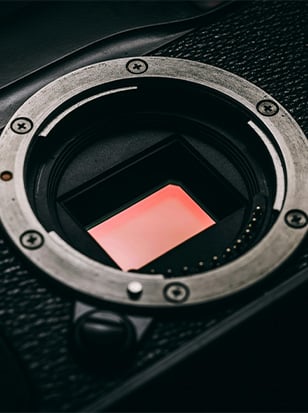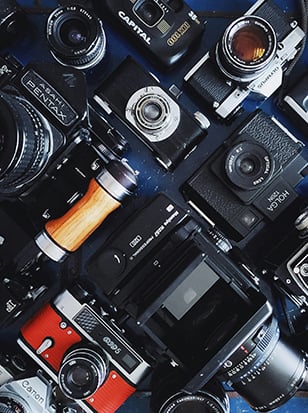
As April ends, we look at the newest and best gear to be released - and it’s been eventful. This is also a sign of things to come for the year ahead. In a world where it feels difficult to imagine new innovation, we are still seeing new products that seem to push the boundaries of what is possible and, interestingly, what is becoming the new standard of quality and photo and filming capability.
This month, the big news comes from both the stills and video space. We’ve seen a range of noteworthy lenses from Canon, Sony, and Samyang, as well as new cameras from Nikon, Fujifilm, and Insta360. For video, Blackmagic released its latest high-end digital film camera, which offers incredible performance and quality. Let’s kick things off with arguably the most interesting launch…
|
Sensor: 24.5MP full-frame CMOS Processor: EXPEED 7 Autofocus: 3D tracking with subject detection for 9 types Video: 4K UHD at 60p (cropped), N-RAW recording Stabilisation: 7.5-stop in-body VR |
The Nikon Z5 II raises the bar – and we’re here for it. So, what’s new? First off, there's a “new” sensor. It’s actually the same sensor found in cameras like the Z6 II. While not brand-new, it’s a huge step up from the original Z5’s ageing chip (which dates back over a decade). It’s significantly faster and delivers much better performance across the board.
Processing gets a serious upgrade too, with Nikon’s latest EXPEED processor – the same one used in the Z8 and Z6 III. That means much-improved autofocus, both in speed and subject recognition. You also get a JPEG burst speed boost: up to 30fps with pre-burst capture, or a staggering 60fps at full resolution and 120fps in APS-C crop mode.
Where the Z5 II really shines is in its hybrid capabilities. Thanks to that updated sensor and processing power, it now shoots full-width 4K up to 30fps and 1080p at 120fps for smooth slow motion – double the frame rate of the original Z5. It also adds product-priority AF, electronic stabilisation, 10-bit N-Log, waveform monitoring and even N-RAW, each previously reserved for higher-end models. If you’re after a true stills/video hybrid, this is a serious contender.
Physically, the design remains familiar, but with a few welcome updates: two custom function buttons and a second control dial on the top plate for faster exposure adjustments. The EVF now reaches a peak brightness of 3000 nits – a huge help in bright conditions.
There are a couple of quirks, though. Nikon has dropped the dedicated MH-25a battery charger – you’ll need to charge via USB-C unless you buy the charger separately. Not a dealbreaker, but a bit of a sting. And unlike the original Z5, this version combines the 3.5mm headphone and remote inputs into one socket, so you can’t monitor audio while using a remote release. Not ideal, but manageable.
If you’re looking to get closer to the action without overloading your kit bag – or your budget – Canon’s new RF 75-300mm f4-5.6 might just be the answer. Designed for EOS R System cameras, this compact telephoto zoom is ideal for beginners or hobbyists exploring wildlife and sports photography.
Telephoto lenses can be intimidating for new photographers, not to mention expensive, but this lens keeps things simple, portable and affordable, while still delivering Canon-level performance. Its f4-5.6 aperture offers effective control over depth of field, making it easier to create that satisfying subject-background separation. Inside, you’ve got 13 elements in 9 groups for consistent sharpness across the zoom range, while Canon’s Super Spectra Coating helps reduce flare and enhance contrast.
A 7-blade aperture delivers smooth, natural bokeh, and at just 507g and 146.1mm in length, it’s a lightweight, easy-to-handle option for photographers on the move. So, whether you're tracking fast action or capturing distant wildlife, this is a smart entry point into telephoto shooting for EOS R users.
|
Focal Length: 50–150mm Maximum Aperture: f2 Design: Internal zoom with declickable aperture ring Weight: 1,340g Build: Dust and moisture-resistant |
Sony’s FE 50-150mm f2 G Master lens is built with hybrid creators in mind, with a combination of versatility, speed and clarity across a zoom range that’s perfect for portraits, events, fashion and even fast-paced sports. It delivers consistent performance with the kind of image quality you'd expect from Sony’s flagship G Master series.
The constant f2 aperture gives excellent low-light capability and control over depth of field, paired with an 11-blade circular diaphragm for smooth, natural bokeh. Inside, the optical construction features 19 elements in 17 groups – including XA, ED and Super ED glass – designed to minimise aberrations and maintain sharpness from edge to edge. Its focus is fast and accurate thanks to four XD Linear Motors arranged in two focus groups, making it responsive enough for 4K 120p tracking and reliable eye detection.
One less inviting aspect is that it is notably large and heavy. In fairness, this is due to the optical elements and its internal zoom, so it’s a trade-off between weight and the images it produces. It’s also a hefty investment, but considering what it can do, it’s probably worth it!
|
Focal Length: 14–24mm Maximum Aperture: f2.8 Optics: Three aspherical and two ED elements Features: Ultra Multi-Coating, autofocus with manual override Build: Weather-resistant |
As third-party lenses go, Samyang is certainly a brand that delivers impressive image quality and performance that, in some cases, rivals native lenses. They’ve really come into their own over the time I have been writing for Wex, especially since adding auto focusing to their recent lenses, which was often commented on back in the day.
The new Samyang AF 14-24mm f2.8 Super Wide Zoom lens is another lens in their lineup that is lightweight yet powerful. Weighing just 445g, it delivers sharp, edge-to-edge clarity thanks to a 15-element optical design, while the fast f2.8 aperture makes it a strong choice for landscapes, interiors, and astrophotography, not to mention its 114.2° field of view at 14mm. But, it also has a 0.18m minimum focus distance, allowing for dramatic wide-angle close-ups.
It's also weather sealed for outdoor shooting, and takes standard 77mm filters, meaning it’s a practical, travel-friendly option. And yes, autofocus - A linear STM motor keeps autofocus quick and quiet. It’s a solid lens and one we’d wholeheartedly recommend.
|
Resolution: 8K at 30fps, 5.7K at 60fps, 4K at 120fps Sensors: Dual 1/1.28" CMOS Features: 360° capture, LOG HDR recording, PureVideo low-light mode Audio: Enhanced wind noise reduction Stabilisation: FlowState with horizon lock |
How else can they improve on their 360-degree cameras? Well, the main points here are that this model has a bigger sensor, offers better low-light, and, most intriguingly, swappable lenses.
But the X5 also features a built-in windscreen, which is designed to reduce wind noise and improve audio quality. And, the camera has improved battery life, with the ability to film for up to 83 minutes on a single charge in 8K 30fps. Speaking of video, the new PureVideo mode is designed to reduce noise and enhance low-light footage, and supports filming in LOG, which allows for more control over the colour grading process in post-production.
Slight drawbacks include a slightly larger and heavier design, and it costs more than the X4, and while it isn’t an enormous amount, it’s kind of frustrating, but not unexpected considering the world we live in.
|
Film Type: Instax Mini instant colour film Exposure: Automatic light adjustment with programmed electronic shutter (1/2 to 1/250 sec) Features: Close-focus mode with parallax correction, selfie mirror Power: AA batteries Design: Retro-inspired plastic body |
You might think we’d be over Instax and the news of another version would bore us… but you’d be wrong. We love Instax. Has there ever been anyone who doesn't love a nostalgic photo of themselves on holiday or at a party in the form of a credit card-sized instant print they can hold in their hand? No, that person doesn’t exist.
We all know about Instax cameras, so it’s best to cover what’s new. Design-wise, it’s had another facelift that is styled to look like a vintage film camera, fit with a sleek grey finish with old-school diamond-knurled finish around the lens and most of the body. This not only looks great but also offers some grip.
This version offers an improved close-up mode with parallax correction. In English, this correction is about making sure what you see in the viewfinder or screen lines up exactly with what the lens sees. If it's not corrected, the subject might appear to shift slightly when you move your eye or change your angle. This means you ensure accurate framing and focus when you use this mode.
It’s compatible with all Fujifilm Instax Mini film and is powered by AA batteries. It really is a simple but highly effective system!
|
Sensor: 12,288 x 8,040 full-frame RGBW Dynamic Range: 16 stops Recording: Up to 12K at 40fps, 8K at 112fps Media: Dual CFexpress slots Mount Options: Available in EF, PL, and L-Mount |
Also available in EF and PL mounts
Finally, we have the Blackmagic PYXIS 12K. This is a professional digital film camera built for serious filmmakers. It features a full-frame 36 x 24mm sensor capable of capturing stunning 12K resolution (12288 x 8040) with 16 stops of dynamic range, which is ideal for cinematic productions and high-end commercial work. It records internally in Blackmagic RAW, with support for high frame rates up to 112fps at 8K, and offers dual CFexpress slots, USB-C recording, and built-in live streaming.
All of this is housed in a rugged aluminium chassis, which also includes a 4-inch HDR touchscreen, pro audio inputs, 12 G-SDI out, and full DaVinci Resolve Studio. If you’re a professional filmmaker, you’ll know how significant and powerful this all-in-one production solution is.




















